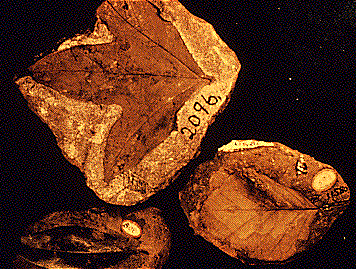Impressions
Fossils: Window to the pastImpressionsWhat are impressions?Impressions are two dimensional imprints of an organism that doesn't
contain any organic material. Impressions hold clues to organisms'
biological activity; they can be What do impressions tell us?Impressions offer valuable information and are effective tools for the reconstruction of prehistoric environments. Impressions left by amphibians and reptiles in Paleozoic rocks has shown the way in which these ancient animals (otherwise known only by their skeleton structure) moved. Impressions left by the fearsome dinosaurs allow us to determine the environment in which these enormous reptiles lived. Through impressions, paleontologist are able to draw upon relationships that existed among various organisms in certain geographical areas. However, impressions do present some problems to paleontologists. They are often difficult to encode, especially marine organisms. It is sometimes to hard to establish what kind of invertebrate may belong to a specific impression or certain borings in rocks. |
 formed
while an organism is moving or engaged in another function. Some examples
of impressions are trace fossils: footprints, traces, remains
of tunnels left by burrowing organisms, fossilized excrement, and the
holes made in shells by parasites. Impressions usually occur in fine-grained
sediment such as clay or silt. Impressions
of plant remains have been found frequently in clay pits. Many remnants of Eocene plants have been found
in the clay pits of Puryear, Tenessee.
formed
while an organism is moving or engaged in another function. Some examples
of impressions are trace fossils: footprints, traces, remains
of tunnels left by burrowing organisms, fossilized excrement, and the
holes made in shells by parasites. Impressions usually occur in fine-grained
sediment such as clay or silt. Impressions
of plant remains have been found frequently in clay pits. Many remnants of Eocene plants have been found
in the clay pits of Puryear, Tenessee.